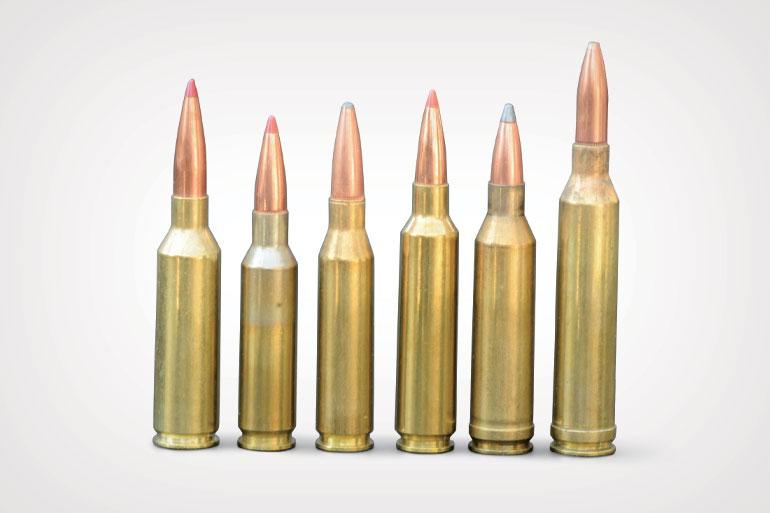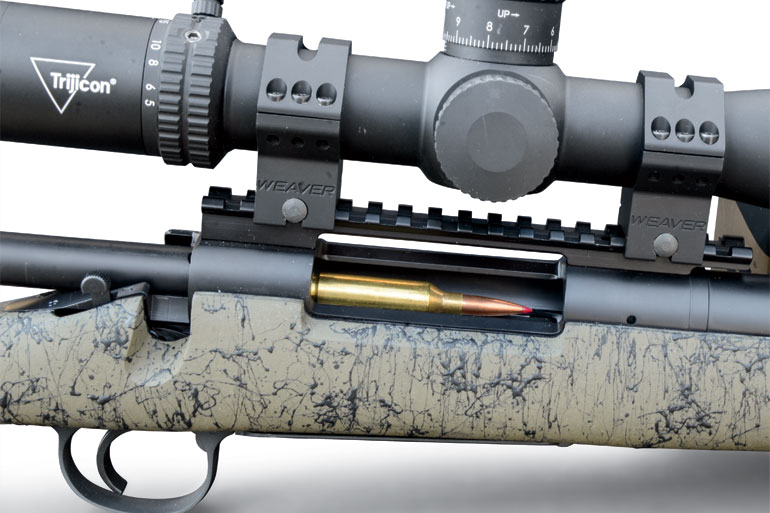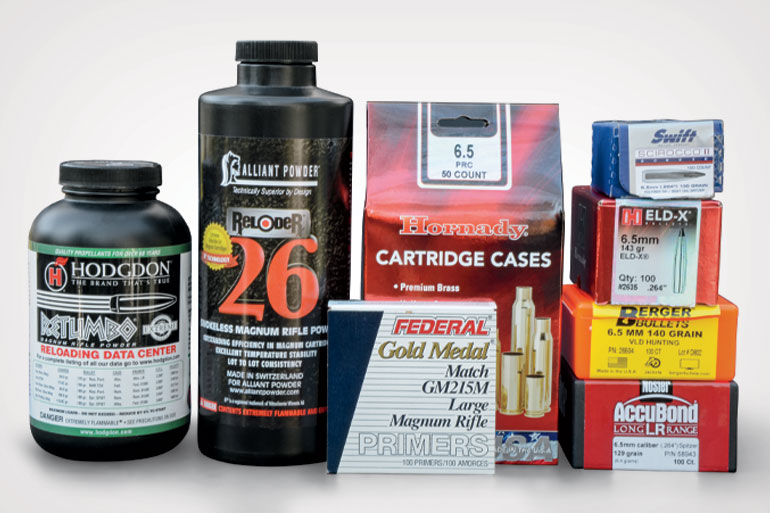
When I first got my hands on some 6.5 PRC ammunition from Hornady, my initial thought was how its performance would compare with other factory cartridges of the same caliber.
A comparison of case capacities is a good starting point for finding out. When filled to the brim, gross water capacity of the 6.5 PRC averaged 67.6 grains. Moving down to smaller capacities, we have 6.5 Creedmoor and 6.5-284 cases made by Hornady at 53.4 grains and 64.3 grains respectively. Moving up to a couple with bigger capacities, we have the 6.5 Remington Magnum at 70.2 grains and the .264 Winchester Magnum at 84.1 grains. Capacities for the 26 Nosler and 6.5-300 Weatherby Magnum are 98.2 and 96.7 grains respectively.
As you can see, the 6.5 PRC holds just over 3 grains more powder than the 6.5-284 and just under 3 grains less than the 6.5 Remington Magnum.
My next step was to compare velocities of the three cartridges in rifles with 26-inch barrels. Before going there, let’s take a close look at our newest cartridge of its caliber.
The 6.5 PRC (Precision Rifle Cartridge) story begins back in 2012 when George Gardner, owner of GA Precision, who is heavily involved in PRS (Precision Rifle Series) competition, approached Hornady about developing a big brother to the 6.5 Creedmoor on the RCM (Ruger Compact Magnum) case. It would be used mainly for banging steel targets beyond 1,000 yards. But that was when the Obama administration was selling far more ammunition for Hornady than the company could produce, and the time and machinery required for developing a new long-range rifle cartridge were not available.

So Gardner necked down the 7mm Remington Short Action Ultra Magnum case for 0.264-inch bullets. Remington brass eventually became difficult to find, but by then Hornady was caught up enough to begin producing what would eventually add up to thousands of 6.5mm SAUM cases, all sold through GA Precision. They are headstamped “6.5 GAP 4S,” but the cartridge is more commonly known in hunting and competition circles as the 6.5 SAUM. It is simply the 7mm SAUM case necked down.
Considering the production by Hornady of 6.5 GAP 4S cases, the next logical step appeared to be ammunition coming off the line in Grand Island, Nebraska. Instead, the Hornady-developed RCM case was used to produce the 6.5 PRC. A maximum case length of 2.030 inches makes it 0.015 inch longer than the .338 Compact Magnum case and 0.070 inch shorter than the .300 Compact Magnum. All share a 30-degree shoulder angle.
Most 6.5 GAP 4S rifles are custom jobs, and while plenty of custom rifles in 6.5 PRC are likely to be built, the availability of less-expensive factory rifles from Savage, Montana Rifle Co., Sauer, and others likely to follow makes it more affordable than the 6.5 SAUM. Other advantages are the availability of factory ammo and a reliable supply of less-expensive unprimed cases from Hornady.
Two 6.5 PRC factory loads are currently offered. Hornady Match is loaded with the 147-grain ELD Match bullet at an advertised 2,910 fps, and Precision Hunter pushes the 143-grain ELD-X along at 2,960 fps. Load data is no farther away than the Hornady and Hodgdon websites. Most who publish pressure-tested data will likely stay below the SAAMI maximum of 65,000 psi. Hodgdon stopped at 61,500 psi and 2,995 fps for a 140-grain bullet from a 24-inch pressure barrel. The Hornady data sheets I have don’t include chamber pressures, but maximum velocities listed from a 26-inch barrel are 3,150 fps for 140- and 143-grain bullets and 3,050 fps for the 147-grain ELD Match.
The 6.5 SAUM has proven capable of consistently delivering accuracy inside 1/2 MOA from accurate rifles, and to see if the 6.5 PRC is capable of equaling that, I shot it in a precision-built rifle put together by Don Fraley, owner of Advanced Weapons Technology in Russell, Kentucky. His rifles are on blueprinted Remington Model 700 actions, and since early reports described the 6.5 PRC as a short-action cartridge, we initially assumed the test rifle would be on the short version. Digging a bit deeper revealed that the new cartridge is too long for the short Remington Model 700 magazine. With an interior length of 2.840 inches, it restricts cartridge length to a maximum of 2.815 inches. SAAMI maximum for the 6.5 PRC is 2.955 inches, with the two Hornady factory loads measuring 2.950 inches.

A partial solution does exist. The interior length of Wyatt’s Outdoor magazine box for the short Model 700 action is 3.060 inches, and deducting 0.025 inch from that we arrive at a maximum useable cartridge length of 3.035 inches. Its installation requires light machine work on the receiver and modifying the boltstop, both easy tasks for a skilled gunsmith. That magazine will accept Hornady 6.5 PRC ammo, but very little wiggle room remains for chasing the rifling with handloads as chamber throat erosion requires seating high-BC bullets farther out of the case.
Everything considered, I became convinced that the long Model 700 action is the easiest way to squeeze top velocities from the 6.5 PRC while staying within SAAMI maximum chamber pressures. I tried the 6.5 PRC in the magazines of several Model 700 rifles in various calibers, and feeding was flawless in one in .300 Remington Ultra Magnum. The long Model 700 action is only 3 ounces heavier than the short action, so when heading for the hills, I will compensate by leaving a candy bar behind. Using what was originally intended to be a short cartridge in a long-action rifle is hardly new. When loaded with some of the old-school bullets, the original 6.5-284 wildcat works fine in a short action, but seat the new breed of high-BC bullets long and change its name to 6.5-284 Norma and a long action is required.
A Special Test Requires a Special Rifle
The Advanced Weapons Technology rifle I used for accuracy-testing the 6.5 PRC is the Long Bow model. It has a tactical-style bolt handle, an M16-style extractor, and a Lawton/Nosler exterior bolt release from Pacific Tool & Gauge. The HS Precision Pro-Series stock is a combination of fiberglass, Kevlar, and carbon fiber. Steel-reinforced bedding compound applied by Fraley extends from the tang of the receiver to 1.5 inches beyond the recoil lug.
The 26-inch Select Match barrel from Shilen has that company’s ratchet rifling at a 1:8 twist, and the contour is listed by Shilen as Heavy Sendero. It free-floats in the stock. Pertinent chamber dimensions are a 0.2985-inch neck diameter, a 0.2645-inch throat diameter, and a 0.2050-inch throat length. The barrel has an 11-degree crown at the muzzle, and it wears an extremely efficient and surprisingly quiet AWT eight-port brake. The barreled action has a black Cerakote finish. Measured with a Lyman digital scale, the Timney 510 trigger breaks crisply at 35 ounces with a 2-ounce variation. There is no detectable creep or overtravel. The rifle came with a 20-MOA Picatinny base installed, and for accuracy-testing, a Trijicon AccuPower 5-50X 56mm scope in Weaver 34mm tactical rings was used.

The accuracy of different loads fired in a precision-built rifle will vary a bit in accuracy, but the spreads are usually quite close compared to mass-produced factory rifles. Fraley guarantees his rifles to consistently shoot five bullets inside a half-inch at 100 yards, with precision handloads pushing accuracy in the direction of 1/4 MOA.
When good handloading practices and quality equipment and components are combined with a bit of bullet jump and powder charge juggling, it’s fairly easy to produce ammunition capable of half-minute accuracy, but shrinking group size to half that usually requires precision loading. Hornady 6.5 PRC cases were trimmed to the exact same length and their mouths chamfered and deburred. Cases were then capacity sorted and their necks outside-turned just enough to uniform neck wall thickness. Doing so reduced neck wall thickness by only 0.0005 inch, which put diameter of a loaded round at 0.291 inch compared to 0.292 inch for Hornady factory ammo. Primer pockets were uniformed, and flash holes were uniformed and deburred. Prior to being seated, all bullets went through a bullet-sorting stand from Sinclair International. Powder charges were weighed with an RCBS Model 304 scale, and RCBS Gold Medal Match dies were used in a Corbin CSP-1 bullet-swaging press converted for ammunition loading. A 0.289-inch bushing was used in the RCBS neck-sizing die.
In addition to consuming a lot of time, developing a precision load for just a single bullet-powder combination capable of equaling the accuracy of a super-accurate rifle can use up a lot of barrel accuracy life. For that reason, only four bullets were precision-loaded specifically for the test rifle. When accuracy-testing an extremely accurate big-game rifle, I usually shoot three-shot groups, but since the barrel of the Fraley rifle had a rather heavy contour with a muzzle diameter of 0.825 inch, I fired five-shot groups. To illustrate velocities possible with other bullet-powder combinations, I simply worked up to maximum in non-prepped cases.
Most who shoot the 6.5 SAUM use the Federal 215 and CCI 200 Magnum primers, so I was a bit surprised to see both Hornady and Hodgdon use standard-force primers when developing data for the 6.5 PRC. I tried Federal’s GM215M and GM210M primers, and while accuracy was about the same, velocity spread was lower with the former. It was not enough to matter at ethical game-taking distances, but it was enough to matter to those who punch paper or steel at 1,000 yards and beyond.

Comparison Results
How does 6.5 PRC performance compare with its two closest competitors, all in 26-inch barrels? My Ruger No 1S in 6.5 Remington Magnum departed the factory in July 1965, and I purchased it new-in-box from a friend in 1978. I could never get it to shoot accurately enough to make me entirely happy until Randy Brooks introduced his Barnes X-Bullet in 1985.
Soon after adding a Cooper Model 22 in 6.5-284 Norma to my battery, it accounted for my second-best whitetail deer. My handload consisted of 53.5 grains of Reloder 19 behind the Swift 130-grain Scirocco II. The Model 22 is proof that you don’t have to have a custom rifle in order to enjoy superb accuracy.
Three different rifles might have slightly different stories to tell, but when the three cartridges are loaded to maximum with 140-grain bullets and fired in my rifles, the 6.5 PRC is about 100 fps slower than the 6.5 Rem. Mag. and about 100 fps faster than the 6.5-284 Norma. The 6.5 Rem. Mag. has long been one of my favorite cartridges, but since factory ammo and unprimed cases can be difficult to find, I have to recommend the other two cartridges over it. If, like me, you already have a rifle chambered for 6.5 Rem. Mag., by all means keep it active in the field because it is a great cartridge. But if you are shopping for a new rifle, the other two are better choices.
As it now stands, there are more sources for 6.5-284 Norma ammunition than for 6.5 PRC, although actual availability can vary due to fluctuations in production scheduling. A steady supply of ammunition gives the 6.5 PRC an edge among those who shoot factory ammo, but due to the availability of unprimed cases for both, handloaders should be equally happy with either cartridge. Those among us who cannot resist praising the new without condemning the old will point to the rebated rim of the 6.5-284 case, but decades of experience with that cartridge have not revealed a single problem with it. On the other hand, off-the-shelf factory rifles in 6.5 PRC may eventually far outnumber those in 6.5-284 Norma, and if that happens, it will have a big edge on the road to commercial success.










































